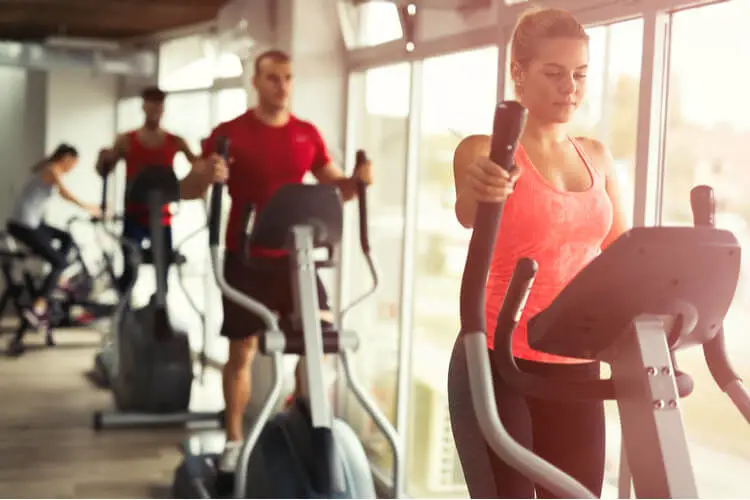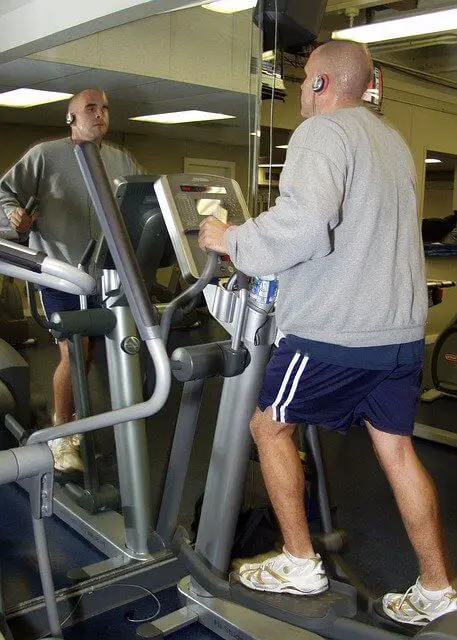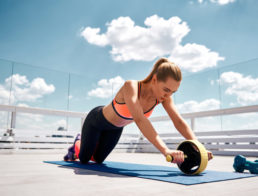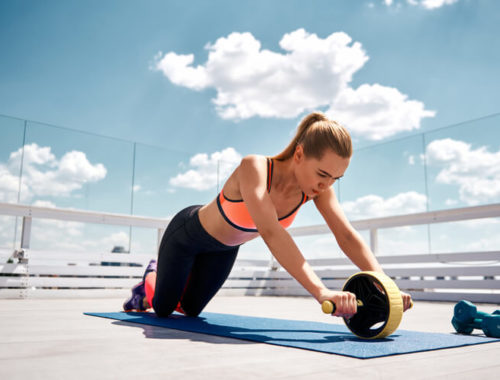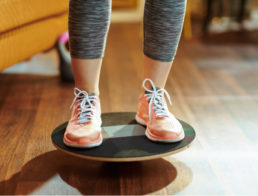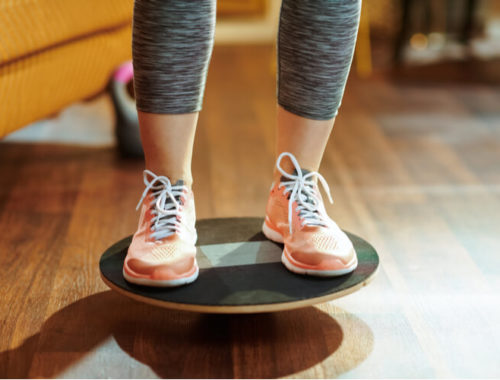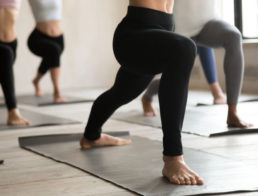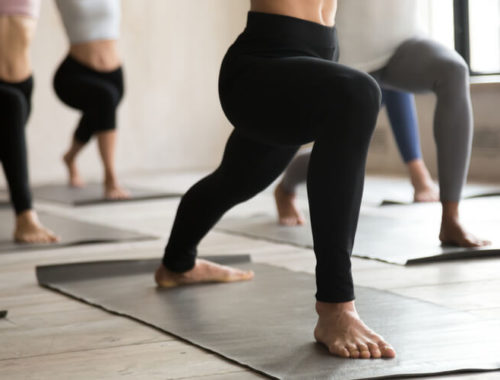Ellipticals provide an adaptable, full-body workout that’s easy on the joints. They offer some distinct advantages over other cardio machines that make them a favorite for injured runners, people just starting their fitness journey, and hardcore exercise enthusiasts looking for a challenge. Ellipticals can help you blast through calories and provide a versatile range of workout choices. They’re also available at a high quality and great value. The benefits start with your heart and lungs and end with a machine that can keep boredom from sinking in. Take a look at the long list of benefits these machines offer your body.
1. Increase cardiovascular fitness
The health of the cardiovascular system affects the strength of your heart and lungs, ability to heal (effective blood flow), and ability to maintain a consistent body temperature (homeostasis), among other important body functions. 1 Ellipticals challenge your heart and lungs to keep up with the demand of hard work. Depending on the program parameters, an elliptical can offer a better cardiovascular workout than a treadmill because they engage the upper and lower body at the same time. 2
2. Boost stamina
Image courtesy of Pixabay
While you’re strengthening your cardiovascular system, you’re also boosting your stamina. Stamina is the ability to maintain a certain level of physical exertion over an extended time period. And, it doesn’t just magically happen. It requires steady, gradual progression that allows the body to adapt to increasing levels of strain and effort. As your heart and lungs get stronger, they can maintain the required level of exertion longer, increasing your stamina. 3
3. Low impact
Ellipticals are considered a low-impact exercise that’s easier on the joints and soft tissues than high-impact exercises. High-impact exercises like running, jump roping, and doing burpees can put the hips, knees, and ankles under stress. People with joint issues can safely use an elliptical without injuring or irritating the joints. An elliptical can give you a low-impact cardio workout that’s similar to running but not as hard on your body. 4
4. Burn calories
Some people forgo an elliptical for the treadmill simply because they think treadmills burn more calories. While it’s true that a treadmill can incinerate calories, an elliptical can do an equally efficient job. Ellipticals utilize both the upper and lower body, giving them the potential to burn just as many if not more calories in a single session. 5 All it takes is increasing the resistance level and effort to increase the calorie burn to equal your favorite running workout.
5. Develop balance and coordination
It takes coordination and balance to get on and maintain a steady cadence on an elliptical. (Don’t take that to mean that they’re too difficult for beginners because they aren’t.) Tighten your core to pinpoint your center of balance. Try to keep your core taut throughout the workout even when fatigue sets in. A tight core helps develop a healthy posture and keeps you balanced as you move through the leg and arm movements on an elliptical. 6
6. Target different leg muscles
Your legs contain ten main muscles with a long list of small support muscles mixed in. Those muscles get activated in different amounts based on the type of activity you’re doing. Some ellipticals allow you to adjust the incline/decline levels of the foot pedals, which changes the activated leg muscles. For example, when the incline gets cranked up, the calves get activated, while the glutes go into overdrive at steeper inclines. You can work areas of weakness or make sure you’re giving equal attention to all of your leg muscles.
7. Full-body workout
Image courtesy of Pexels
One of the major benefits of an elliptical over a treadmill or stair-stepper is the elliptical’s ability to activate the entire body from the back, shoulders, and arms to the quads, glutes, and calves. It’s a full-body workout that you can adjust to your fitness level. That helps burn more calories and build endurance.
8. Nurse injuries to health
Ellipticals are a go-to for injured runners, athletes in high-impact sports, and those recovering from lower-body injuries. The elliptical design works with natural body mechanics and softens footfalls. Consequently, you can maintain your cardiovascular health while your body heals. If you’re recovering from an injury, especially one related to running, an elliptical can give you a low-impact cardio workout that’s similar to running but that’s not as hard on your body. 7
We mostly think of the lower body when talking about low-impact exercises, but the fluid motion of an elliptical can benefit upper body issues like back pain or injuries, too. 8 You can build upper body strength and coordination, which can further reduce back and upper body pain.
9. Workout variety
Many ellipticals include several preprogrammed workout options. Interval training, hills, or cardio workouts where incline and resistance are adjusted for you can spice up your workout variety. It’s a great way to change up your workout, so you don’t get bored. A changing workout design also prevents plateauing, where you burn fewer calories doing the same workout.
A Safe Cardio Challenge
Ellipticals keep you working while protecting your body from injury. They’ll get your heart going and provide a way to continually challenge yourself day after day. Whether you’re injured or looking for a way to change up your routine, an elliptical makes a great option.
Article Sources
Healing Daily uses only high-quality sources, including peer-reviewed studies, to support the facts within our articles. Read our editorial process to learn more about how we fact-check and keep our content accurate, reliable, and trustworthy.
- Introduction to the cardiovascular system. cancer.gov Accessed August 17, 2021
- Sweitzer ML, Kravitz L, et al. The cardiopulmonary responses of elliptical crosstraining versus treadmill walking in CAD patients. Journal of Exercise Physiology online. 2002. 5(4) Published November 2002. Accessed August 17, 2021.
- Bolotin A and Bakayev V. Model for Stamina Development in Biathletes Based on the Combined Application of Respiratory Exercises. Sport Medicine. 2019. 17(3): 59-65 doi: 10.26773
- Bosch AN, Flanagan KC, Eken MM, Withers A, Burger J, Lamberts RP. Physiological and Metabolic Responses to Exercise on Treadmill, Elliptical Trainer, and Stepper: Practical Implications for Training. Int J Sport Nutr Exerc Metab. 2021;31(2):135-142. Published 2021 Jan 20. doi:10.1123/ijsnem.2020-0155
- Jensen M, Hsu-Han H, et al. A comparison of energy expenditure when exercising in 10 indoor exercise machines. Int. J. Appl. Exerc. Physiol. 2019. 14(2): 84-94. Published 2019. Accessed August 17, 2021
- Kahle N and Tevald MA. Core muscle strengthening’s improvement of balance performance in community-dwelling older adults: A pilot study. Journal of Aging and Physical Activity. 2014. 22(1): 65-73. doi: 10.1123/japa.2012-0132
- Bosch AN, Flanagan KC, Eken MM, Withers A, Burger J, Lamberts RP. Physiological and Metabolic Responses to Exercise on Treadmill, Elliptical Trainer, and Stepper: Practical Implications for Training. Int J Sport Nutr Exerc Metab. 2021;31(2):135-142. Published 2021 Jan 20. doi:10.1123/ijsnem.2020-0155
- Dillingham T, Kenia J, Popescu A, Plastaras C, Becker S, Shofer F. Pain Outcomes with an Elliptical Regimen (POWER) Study: Identifying the Proper Dosage of Exercise for Therapeutic Effect in Persons with Chronic Back Pain. J Phys Med Rehabil. 2020;2(2):23-28.
